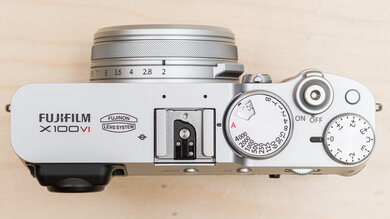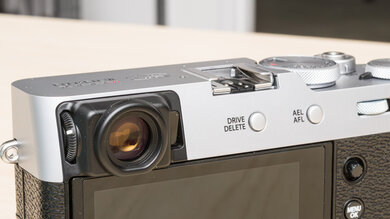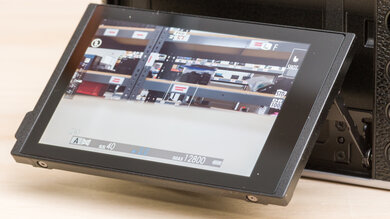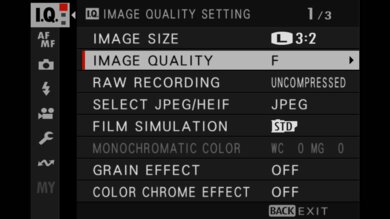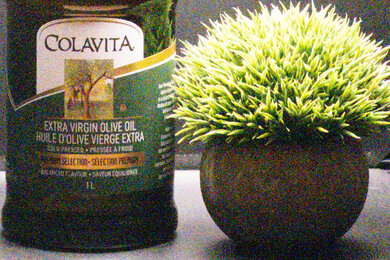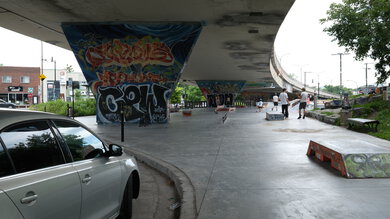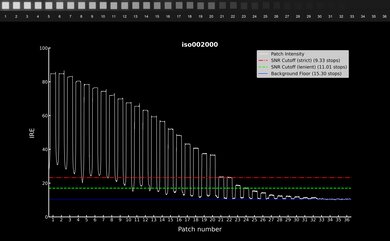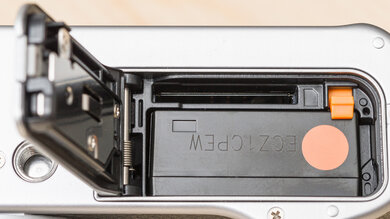The Fujifilm X100VI is the long-awaited follow-up to the incredibly popular Fujifilm X100V. With a brand new 40.2-megapixel sensor—the same one found in the Fujifilm X-H2 and Fujifilm X-T5—and in-body image stabilization, it improves upon the formula that made the X100V such a hit. Otherwise, it features the same excellent f/2 lens with a 35mm full-frame equivalent focal length, hybrid optical viewfinder, and compact, rangefinder-style design, complete with dedicated exposure dials that give it the old-school, photography-first feel that Fujifilm is known for.
Our Verdict
The Fujifilm X100VI is very good for travel photography. Though it isn't the smallest fixed-lens compact camera on the market, it's still very portable, and its high-resolution sensor captures excellent image quality with plenty of detail and flexibility to crop in. Its lens has a wide max aperture to give you some more leeway in low light, and its optical rangefinder is well-suited to capturing busier street scenes or anticipating a subject's movement in or out of the frame. IBIS comes in handy when forced to shoot at slower shutter speeds handheld. Lastly, its tilting screen makes it easy to shoot at waist level or from above. However, it doesn't have the longest battery life, and its fixed focal length may be limiting to those who prefer to zoom in on their subjects from farther away.
-
Compact design.
-
Hybrid optical/electronic viewfinder.
-
Sturdy build quality.
-
Battery life is on the shorter side.
-
Fixed 35mm equivalent lens may be limiting to some.
The Fujifilm X100VI is very good for landscape photography. Its compact size makes it easy to take anywhere, and its high-resolution sensor is ideal for capturing detailed images of landscapes, with some room to crop in if needed. It has excellent dynamic range to bring out more detail in high-contrast scenes, though it doesn't have the best noise handling in low light. On top of that, it's a well-built camera, though you have to buy additional accessories to get full weather-sealing. Its ergonomics can also feel a bit cramped to those with larger hands. Plus, its fixed 35mm equivalent field of view may not be wide enough for some landscape photographers. Battery life also isn't especially long, so you'll need to buy a second battery or bring a power bank with you for longer hikes.
-
Compact design.
-
Hybrid optical/electronic viewfinder.
-
Sturdy build quality.
-
Battery life is on the shorter side.
-
Fixed 35mm equivalent lens may be limiting to some.
The Fujifilm X100VI isn't really intended for sports and wildlife photography. While it has a quick burst shooting mode, its fixed 35mm equivalent focal length doesn't give you much reach for far-away subjects. Its autofocus is fairly advanced, with a wide range of AI-driven subject detection modes, including birds, insects, cars, and human faces and eyes. However, its tracking isn't the most reliable with busy scenes and far-away subjects. On the upside, image quality is great, and it isn't bad for more casual snapshots of close-up sports or wildlife.
-
Hybrid optical/electronic viewfinder.
-
Sturdy build quality.
-
Quick burst shooting.
-
Battery life is on the shorter side.
-
Fixed 35mm equivalent lens may be limiting to some.
-
Smallish buffer size.
-
Buffer takes a long time to empty once full.
The Fujifilm X100VI is okay for vlogging, but this isn't its intended use. For one thing, you can't flip its screen around to face you, so it isn't suited for self-vlogging. If you tend to shoot other subjects, however, it's a solid video camera for shorter stints, with seriously impressive video specs and high-quality footage. IBIS also helps stabilize your videos when shooting handheld. But the camera also struggles with excessive overheating when recording 4k and higher-quality video for extended periods of time.
-
Compact design.
-
Sturdy build quality.
-
6.2k at up to 30 fps.
-
4k at up to 60 fps.
-
Battery life is on the shorter side.
-
Frequent overheating when recording in 4k or higher resolutions.
-
No fully articulated screen.
-
No headphone jack to monitor audio.
-
Mic input is less common 2.5mm.
While the Fujifilm X100VI has some advanced video specs and excellent internal recording capability, it isn't designed for studio video use. Its form factor is inconvenient for use with videography peripherals, with no headphone jack and only a 2.5mm mic input. It also struggles very much with overheating, preventing you from recording for extended periods of time. That being said, if you just need a compact camera that can capture quick, high-quality video clips or B-roll, the X100VI works well and offers up to 6.2k recording with internal 10-bit 4:2:2 color and Log profiles to get more dynamic range.
-
Sturdy build quality.
-
6.2k at up to 30 fps.
-
4k at up to 60 fps.
-
Internal 10-bit 4:2:2 with F-Log and F-Log 2.
-
Battery life is on the shorter side.
-
Frequent overheating when recording in 4k or higher resolutions.
-
No fully articulated screen.
-
No headphone jack to monitor audio.
-
Mic input is less common 2.5mm.
The Fujifilm X100VI isn't intended for action video. It can record high-quality 4k and 6.2k footage, with a fair range of frame rate options, including a high-speed recording mode that captures 1080p footage at up to 240 fps. However, it overheats very quickly in video mode, and you'll be limited by its fixed 35mm equivalent focal length.
-
Sturdy build quality.
-
6.2k at up to 30 fps.
-
4k at up to 60 fps.
-
High-speed recording mode in 1080p.
-
Battery life is on the shorter side.
-
Fixed 35mm equivalent lens may be limiting to some.
-
Frequent overheating when recording in 4k or higher resolutions.
-
No fully articulated screen.
-
No headphone jack to monitor audio.
-
Mic input is less common 2.5mm.
The Fujifilm X100VI has great RAW image quality. Its high-resolution sensor captures incredible fine detail and its lens delivers sharply rendered photos. It also has excellent dynamic range to preserve a wide range of highlight and shadow detail. However, its RAW noise handling is mediocre, so noise can be quite apparent in low light situations in which the amount of light hitting the sensor is limited and you're forced to bump up the ISO.
-
Excellent dynamic range.
-
Fantastic detail preservation.
-
Passable noise handling.
- 7.8 Travel Photography
- 7.8 Landscape Photography
- 7.7 Sport & Wildlife Photography
- 6.4 Vlogging
- 7.9 Studio Video
- 6.0 Action Video
Performance Usages
- 7.9 Raw Photo
Changelog
-
Updated Feb 10, 2025:
We wrote text for the new tests added in Test Bench 0.13.
-
Updated Feb 07, 2025:
We added a comparison to the Leica D-Lux 8 in the Built-in Lens section.
- Updated Feb 03, 2025: We've converted this review to Test Bench 0.13. We've added new tests for Video Dynamic Range and Luminosity Patch Detection. You can learn more about these updates in the changelog.
-
Updated Jan 16, 2025:
We added a mention of the Fujifilm X-M5 in the Built-In Lens section.
- Updated Jul 25, 2024: Review published.
Differences Between Sizes And Variants
The Fujifilm X100VI comes in two colors: Black and Silver. We purchased the silver model, and you can see our unit's label here.
There's also a Fujifilm X100VI Limited Edition variant released to celebrate Fujifilm's 90th anniversary. The limited edition model has a serial number engraved on the hot shoe, original Fuji logos engraved on the top plate and lens cap, a special rope strap, a titanium shutter button, and a soft-release button for the shutter. These were limited to 1,934 units worldwide.
Compared To Other Cameras
The Fujifilm X100VI, like its predecessor, is incredibly in demand, and for good reason. This premium compact camera fills a niche that few other cameras do with a portable design, a high-quality f/2 prime lens, a unique hybrid viewfinder, IBIS, and a high-resolution APS-C sensor. You might find some of those features on competing cameras, but you certainly won't find them all in one camera anywhere else. Still, despite its popularity among the TikTok crowd, the X100VI's high price and feature set aren't for everyone. This is a high-end photographer's camera, first and foremost, aimed at enthusiasts and pros who want a fixed-lens everyday carry camera that doesn't compromise on image quality.
If you're looking for other options, be sure to check out our recommendations for the best point-and-shoot cameras, the best travel cameras, or the best digital cameras we've tested overall.
The Fujifilm X100VI is the successor to the highly popular Fujifilm X100V. While the cameras look nearly identical and feature the same excellent built-in lens, the X100VI has some notable improvements over the X100V, including a new higher-resolution sensor, an updated autofocus system, in-body image stabilization, and some improved video features, like 6.2k recording and more frame rate options. Still, if you don't need the latest and greatest features, you won't be disappointed by the older model.
Although the Fujifilm X-M5 and the Fujifilm X100VI share some similarities, they're quite different. The X-M5 is an interchangeable lens model, while the X100VI has a fixed prime lens, making it more niche. On the surface, that makes the X-M5 more versatile, since you can pair it with a wide range of lenses. However, the X100VI has some advantages over the X-M5, including a higher-resolution sensor and a hybrid optical/electronic viewfinder. For casual photography and vlogging, the X-M5 offers better value for most people, but the X100VI is a better option for photographers who want a premium fixed-lens point-and-shoot.
While these are both premium, in-demand compact cameras, the Fujifilm X100VI is better than the Leica D-Lux 8 overall. It's less portable, but it has a larger APS-C sensor with a higher resolution and higher-quality prime lens, and thus captures better overall image quality. It also has significantly better video features, as well as a hybrid optical/electronic viewfinder.
The Fujifilm X-T5 and the Fujifilm X100VI share the same high-resolution APS-C sensor but have different body designs that are tailored to different uses. The X-T5 is the better option if you prefer the flexibility of interchangeable lenses, while the X100VI is better if you need something compact and don't mind a fixed lens. The X100VI also has the benefit of a hybrid optical/electronic viewfinder, but it's less suited to video work and has a shorter battery life than the X-T5.
The RICOH GR III and the Fujifilm X100VI are both excellent point-and-shoot cameras. While they both fill a similar niche for those who want a premium compact camera for street photography, each one has its place—and its own vocal fanbase. The RICOH is significantly smaller and more portable, with a more unassuming design that makes it better for those who prefer to be discreet. The Fuji, meanwhile, is flashier, with more features, including a hybrid viewfinder, a tilting screen, and excellent video specs. The good news is that both cameras are capable of capturing excellent images.
At first glance, the Nikon Z f and the Fujifilm X100VI may appear to fill similar niches. Both have stylish, retro-inspired designs that seem perfectly made to appeal to both street photographers and TikTok influencers. But, beyond that, they're quite different. The Nikon has a full-frame sensor and interchangeable lens design, while the Fujifilm uses an APS-C sensor and a fixed 35mm full-frame equivalent lens. Ultimately, if you want something more compact and portable, get the Fujifilm, but if you need more versatility, get the Nikon.
The Fujifilm X100VI and the Sony α6700 are quite different—the Fujifilm is a fixed-lens point-and-shoot, whereas the Sony is an interchangeable-lens camera. Both use excellent APS-C sensors, but the Sony is better for hybrid photo and video work, with a longer battery life and less overheating with prolonged video recording. The Fuji, however, is much more compact and works better as a smaller everyday carry camera for street and travel photography.
Test Results
The Fujifilm X100VI is quite portable. Because of its new in-body image stabilization system, it's a tad heavier and thicker than the Fujifilm X100V, but the difference is marginal. Overall, it isn't nearly as compact as other point-and-shoots like the Sony RX100 VII or RICOH GR III / RICOH GR IIIx, but considering its large sensor, tilting screen, viewfinder, and IBIS, it's still remarkably small, especially compared to most interchangeable-lens models.
The X100VI feels very well-built. It has hard, textured plastic all around the body, with aluminum top and bottom plates that give it some heft and a more premium feel. However, like the Fujifilm X100V, the camera is only partially weather-sealed. You have to purchase the AR-X100 adapter ring and PRF-49 protection filter at additional cost if you want full weather-sealing.
The buttons and dials feel sturdy and offer good physical feedback. The screen tilting mechanism also feels sturdy. There's a hot shoe cover to protect the electronics of the hot shoe. But, while the battery and SD card compartment are covered by a secure, locking hinged door, the inputs on the side of the camera are only secured with a plastic cover that clicks into place and feels a bit more flimsy. Overall, though, it's a very premium, solid-feeling product.
The Fujifilm X100VI has a small bump rather than a full handgrip, so it doesn't offer the most secure hold, but it's still fairly comfortable. Overall, the camera's ergonomics are okay, but the camera may feel a bit cramped for those with larger hands. The plastic around the viewfinder is also a bit uncomfortable to press your eye against. Thankfully, the dedicated exposure dials make it easy for seasoned photographers to adjust settings. There's also a small thumbstick for menu navigation and focus point selection.
The Fujifilm X100VI has the same hybrid optical rangefinder/electronic viewfinder as the Fujifilm X100V. It's a standout feature that lets you toggle between an OVF with frame lines and overlays or an EVF that allows you to preview exposure settings, depth of field, white balance, focus, and film simulation profiles in real time. You can also toggle a small electronic focus preview screen when using the OVF to check that your image is in focus.
The resolution, magnification, and coverage results shown above are for the EVF. The OVF, meanwhile, has an advertised magnification of roughly 0.52x and a coverage area of 95%.
The Fujifilm X100VI has a tilt-out screen. It's sharp, bright, and excellent for waist-level shooting and street photography. It's largely the same as the screen on the Fujifilm X100V, except it has a slightly wider angle of downward tilt, as you can see here, giving you just a bit more flexibility to see the screen when shooting from above. The screen's touch functionality is limited to selecting your AF focus area/subject tracking and activating the shutter. Otherwise, you can also use it to swipe or zoom in when in playback mode. You can't use it to scroll through the menu.
The menu system is quite good overall but isn't the most intuitive at first, especially compared to some competing brands. For example, some of Fujifilm's terminology differs from other brands, like metering settings being labeled 'Photometry.' Still, it's easy to navigate, and thankfully, there are plenty of customization options, including 'My Menu' pages to access your most frequently used settings and the quick menu you can pull up while shooting. Like the Fujifilm X-T5, there's now a video-specific menu when using video mode, which you can see here, making it a bit easier to access relevant settings. There's now also a dedicated firmware update option in the menu, so you can more easily update the camera.
The Fujifilm X100VI uses the same lens as the Fujifilm X100V. It's a tried-and-true lens with a fixed 23mm focal length (equivalent to 35mm in full frame) and bright f/2 aperture. The lens has a built-in 4-stop ND filter, which can come in handy when shooting video or taking photos in brighter lighting conditions. Like previous models in the X100 series, the X100VI uses a leaf shutter built into the lens, which is quieter than a typical focal plane shutter and allows for higher flash sync speeds.
While the camera has a fixed focal length, there's also a 'Digital Teleconverter' setting that crops the image into either a 50mm equivalent field of view or a 70mm equivalent field of view. This is one area where the new model really benefits from its 40.2-megapixel sensor, as you'll still get high-resolution files when using these cropped framing options, namely 20 MP when using the 50mm crop and 10 MP when using the 70mm crop. That said, if you're interested in a premium compact camera with an actual zoom lens, consider the Leica D-Lux 8. Alternatively, if you'd like a highly compact camera but prefer the flexibility to switch out lenses, consider the Fujifilm X-M5.
The Fujifilm X100VI features the same 40.2 MP X-Trans 5 sensor and X-Processor 5 found in the Fujifilm X-T5 and Fujifilm X-H2. According to Fujifilm, the new sensor has "a more light-efficient pixel structure," allowing for a native base ISO of 125, which is an improvement over the 160 base ISO of the Fujifilm X100V.
Also new to this model is the 'Reala Ace' film simulation profile, bringing the total number of film simulations to 20. You can see a couple of samples of Reala Ace, compared to the Standard film simulation, below:
Sample Photo 1: Standard
Sample Photo 1: Reala Ace
Sample Photo 2: Standard
Sample Photo 2: Reala Ace
The Fujifilm X100VI has passable battery performance. It's CIPA-rated for 310 photos when using the EVF or 450 photos when using the OVF. When using its 'Economy' power-saving mode, the rating jumps up to 360 photos when using the EVF, while the OVF rating remains the same. Overall, these ratings aren't bad for a point-and-shoot camera but still fall behind many mirrorless cameras that use bigger, more efficient batteries. Still, CIPA ratings tend to fall on the conservative side, and your real-world battery life will vary significantly depending on your settings, and how you use your camera.
In video mode, meanwhile, the tested battery life is a bit worse. We managed to record continuously for almost an hour using the 4k HQ setting, which isn't great but is better than the 45-minute video battery life that Fujifilm advertises for that resolution. It also supports USB-C charging and external power delivery, so you can extend the battery life with a power bank or dummy battery if needed. However, the camera's significant overheating issues effectively limit how long you can record.
The Fujifilm X100VI can shoot at very quick burst rates. It has a max mechanical shooting speed of 11 fps and a max electronic shooting speed of 20 fps. However, shooting at speeds above 11 fps with the electronic shutter incurs a 1.29x crop. Its image buffer isn't particularly large, especially when shooting in RAW format, but that isn't surprising given its large 40 MP files. You can still fire off a few rounds before it slows down but don't expect unlimited burst shooting. Unfortunately, if you do fill the buffer, it takes a long time for it to finish writing all those files to the card. It's on par with the Fujifilm X-T5, but that's one downside compared to the Fujifilm X100V and its lower-resolution sensor.
The Fujifilm X100VI uses the same AI-driven subject detection AF as the newest generation of Fuji cameras, like the Fujifilm X-T5 and Fujifilm X-H2S. It has an updated autofocus prediction algorithm and offers a plethora of subject detection options, including Animal, Bird, Automobile, Motorcycle, Airplane, and Train. However, some of the implementations could use even more tweaking to make it more intuitive. For example, human face and eye detection modes are in a separate menu from the subject detection modes mentioned above, making it a bit cumbersome if you want to quickly go from tracking a human subject to a vehicle or bird, let's say.
Overall, the continuous autofocus performs a bit better than its predecessor, with a higher rate of keepers, but it still frequently slipped out of focus or shifted to the back wall or mannequin head in our testing setup. It's worth noting, however, that this camera's fixed 23mm lens puts it at a disadvantage for our AF-C Tracking test since we don't adjust for field of view when testing AF-C.
When using a center focus point, rather than relying on tracking, the camera is highly effective. As long as you can keep your subject under the focus point, you'll have little trouble keeping your subject in focus. To that point, it's worth mentioning that the AF point differs when using the EVF versus the OVF. When using the OVF, the focus area is bigger, which could lead to more errors, as the focus can potentially jump to other subjects. We experienced that with our mannequin head, as you can see here.
For the first time in a Fujifilm X100 camera, the X100VI has in-body image stabilization. The IBIS system, along with the camera's small wider-angle lens, make it possible to capture clear handheld images at remarkably slow shutter speeds. That said, stabilization performance can vary depending on many factors, including how steady your hands are. There's also a digital stabilization in video mode that adds some extra stability but comes with an additional 1.1x crop. It's only available when shooting in FHD or standard 4k.
The camera has excellent dynamic range. It captures a wide array of shadow and highlight detail, which is great for high-contrast scenes like landscapes.
The camera captures an incredible level of fine detail thanks to its high-resolution sensor and sharp lens. Photos appear crisp, with a ton of leeway to crop in without losing visible sharpness or detail.
The camera's RAW noise handling is just okay. Given its high resolution, noise appears very fine and becomes quite apparent when shooting in low light. Thankfully, its wide-aperture f/2 lens and IBIS give you more flexibility to either open up your aperture or slow down your shutter speed in low light than most point-and-shoots.
The Fujifilm X100VI is primarily a photography camera, but it does have some great video specs under the hood. Like the Fujifilm X-T5, it records 6.2k at up to 30 fps, oversampled '4k HQ' at up to 30 fps with a 1.23x crop, and sub-sampled 4k at up to 30 fps with no crop or 60 fps with a 1.14x crop. Both of the 4k modes include the option to record regular UHD 4k in a 16:9 aspect ratio or DCI 4k with a slightly wider 17:9 aspect ratio.
On top of that, the camera supports Log recording in F-Log or F-Log2, and it can output 10-bit 4:2:2 video to an external recorder via HDMI. Additionally, you can use the camera as a webcam via USB-C, with no additional software required—simply plug it into your computer, and you're good to go. While these features are impressive, the camera is held back for more intensive video recording by poor heat management, especially when using the higher quality recording settings or higher frame rates.
Note that the MP4 format option is only available at 30 fps, between 50 and 200 Mbps. The camera also lacks an All-Intra option.
The X100VI's default sup-sampled 4k setting allows you to record at up to 30 fps without a crop and 60 fps with a slight 1.14x crop. Once you move up to the oversampled 4k HQ mode, however, there's a 1.23x crop no matter what frame rate you use. Both the 4k HQ and 6.2k resolution options are limited to a max frame rate of 30 fps. That means that if you want to shoot at 60 fps and slow things down, you'll have to use the sup-sampled 4k option.
As mentioned, the X100VI is seriously hampered by overheating, especially when recording in 6.2k or 4k HQ. While there's no recording time limit, we experienced several overheat interruptions when recording continuously in 4k HQ mode. Having said that, the camera's internal recording capabilities are actually quite advanced, with high bit rates and internal 10-bit 4:2:2 capture to give you more flexibility with your footage in post. It's just better suited to shorter recording sessions.
The camera's autofocus is impressive overall in 4k, with noticeably improved human subject tracking over its predecessor. Though focus transitions can be a tad slow, it has little issue keeping moving human subjects in focus. The object tracking, however, isn't quite as effective, being somewhat slow to adjust focus once the object has moved. It's not bad by any means, but it simply isn't as seamless as the best AF systems. The implementation also leaves a little to be desired. It's fine if you want to track one of the subjects included in one of its subject detection options, like a human or automobile, but human face/eye detection are in a separate menu. Meanwhile, if you're tracking a general subject that does fall in the list of subject detection modes, you have to use the 'Wide/Tracking' area mode, which will only track the subject as long as they stay within the frame or focus area. Otherwise, you'll have to use the 'Multi' AF mode. That said, one notable improvement over the Fujifilm X100V is that you can now simply tap a subject on the screen to start tracking, making autofocus in video a bit more intuitive.
Note: We achieved the above results using the '4k HQ' setting. The camera performed better overall in our subject tracking test in 4k HQ and in 6.2k (which you can see here for face tracking and here for object tracking) than it did using regular 4k, most likely due to the 1.23x crop, which provides a closer crop on the subject.
The camera's 4k HQ video quality is fantastic. It's oversampled from 6.2k, resulting in remarkably detailed footage. It does a great job in low light, without too much noise, and with plenty of detail preservation. Naturally, the quality is a bit worse in the sub-sampled default 4k mode, but you also have less of a crop. You can see the regular 4k video quality here and the 6.2k video quality here for comparison.
Unfortunately, when using the cropped 4k HQ mode, the higher quality comes at the expense of a significantly slower readout speed and, therefore, very heavy rolling shutter distortion. The same is true when recording in 6.2k, which you can see here. To reduce rolling shutter, you can use the default sub-sampled 4k setting, which results in a much better 3.67º rolling shutter angle. You can see the regular 4k version here. There's still some noticeable skewing, especially with faster camera movements, but it's less pronounced at moderate panning speeds.
The Fujifilm X100VI can record 1080p video at up to 60 fps, with a high-speed recording mode that can record slow-motion footage at up to 240 fps, giving you plenty of options for various levels of slow-motion. At up to 30 fps, there's no crop, while shooting at 60 fps incurs a 1.14x crop. Meanwhile, the high-speed recording mode incurs a slightly larger 1.23x crop.
As with 4k, internal recording capability is excellent, with 10-bit 4:2:2 capture, and unlike the Fujifilm X100V, there's no longer a recording time limit. You're less likely to experience overheating in 1080p, though it's still possible with prolonged recording or when shooting at higher frame rates.
The autofocus is less effective in 1080p. It still does an okay job tracking moving subjects, but it has some trouble keeping up with faster or more erratic subjects.
FHD video quality is great overall. It's quite sharp and detailed for 1080p, especially in more controlled lighting conditions, but it's still good even in low light, without an overwhelming amount of noise. Note, however, that there's a noticeable drop in detail and quality when using the high-speed recording mode. You can see a test scene extract of FHD video at 120 fps, slowed down to 60 fps, here.
Thankfully, rolling shutter distortion is less noticeable in FHD. It's about on par with the regular 4k recording mode and notably better than the 4k HQ and 6.2k recording modes. You'll see less skewing overall when panning in 1080p.
The Fujifilm X100VI has fantastic dynamic range in video. In F-Log2, it captures a remarkably wide tonal range above the background floor, though the number of clean or usable stops it can capture is closer to around 11 stops. Overall, you'll have plenty of detail to work with when shooting high-contrast scenes.
Tested settings:
- Resolution: 4k
- Frame Rate: 30 fps
- Log Format: F-Log2
You'll have the greatest dynamic range at the camera's base ISO of 1000 in F-Log2, and most of that range is allocated in the shadows, with significantly fewer stops of dynamic range in the highlights.
- Resolution: 4k
- Frame Rate: 30 fps
- Log Format: F-Log2
The Fujifilm X100VI has a single SD card slot, rated for UHS-I cards. It's located on the bottom of the camera, inside the battery compartment, making it a bit tricky to switch out cards when using a tripod. The tripod mount has moved slightly, compared to the Fujifilm X100V, as you can see here, but a tripod will still block the battery and SD card compartment.
You have a typical USB-C port for charging and file transfer, plus a Micro HDMI port and microphone port. However, it's a 2.5mm mic input, so you'll need a 2.5-to-3.5mm adapter to use any mic with a more common 3.5mm input. Unfortunately, there's no headphone jack, so you'll also need a USB-C-to-3.5mm adapter to plug in headphones if you want to monitor your audio in-camera. That's a lot of adapters, and you'd have to give up your USB-C port and, therefore, external charging to do any kind of advanced video recording.
Comments
Fujifilm X100VI: Main Discussion
Let us know why you want us to review the product here, or encourage others to vote for this product.
- 21010
I have read several articles indicating that this model includes an LG Nano IPs panel. is this true or false?
Referencia: https://pcmonitors.info/samsung/samsung-s27ag500-165hz-wqhd-ips-model/
Update: Updated text throughout the review according to Test Bench 2.0, mainly in the Verdict and Motion sections.
- 32120
Hi, Thanks for this review! Just a question: in the post-calibration you wrote a brightness setting of 9. Is It correct? Since its range is 0-100, didn’t you mean 90? Thanks!
We aim to calibrate at a brightness of 100 nits, so we usually need to set the monitor to a low brightness setting, which is the case here :)
- 21010
Hi, Thanks for this review! Just a question: in the post-calibration you wrote a brightness setting of 9. Is It correct? Since its range is 0-100, didn’t you mean 90? Thanks!
Edited 11 months ago: Typo error Update: Clarified that the Samsung Odyssey G5/G51C S27CG51 is another monitor with a higher Contrast for deeper blacks.




